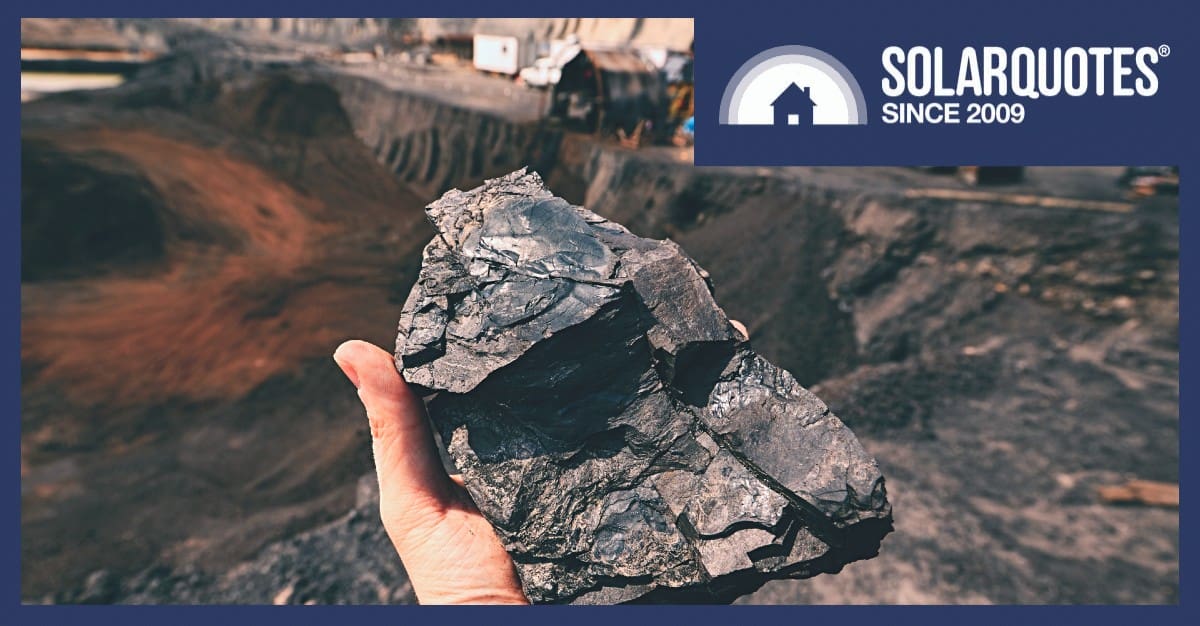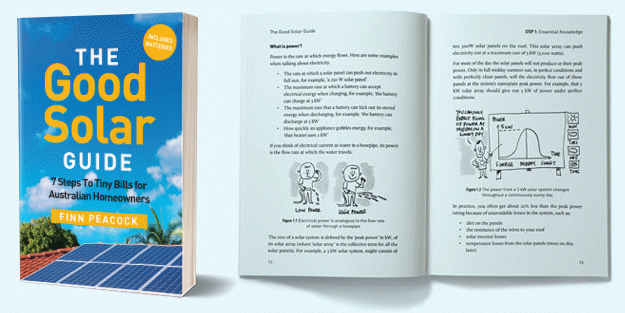 The federal battery rebate is set to play a crucial role in reaching Australia’s new 2035 emissions target, with SolarQuotes analysis revealing that the power output of additional battery storage capacity installed under the scheme will soon match that of Australia’s largest coal plant.
The federal battery rebate is set to play a crucial role in reaching Australia’s new 2035 emissions target, with SolarQuotes analysis revealing that the power output of additional battery storage capacity installed under the scheme will soon match that of Australia’s largest coal plant.
How Much Storage Capacity Has The Federal Battery Rebate Added?
Since the launch of the Cheaper Home Batteries Program on July 1, roughly 161MW of home battery power has been added to the grid per month. At the current pace, the amount added in about 18 months will match the output of Eraring power station – Australia’s biggest coal-fired power plant. Australia’s ageing coal plants are forecast to reach the end of their life in the coming years as Australia moves to cleaner energy sources to achieve its 2035 emissions target.
Batteries Are Rolling Out Fast
Based on figures provided by the Clean Energy Regulator, 43,519 home batteries were installed across July and August with an average nominal capacity of 19.2kWh.
This rapid takeup could prove instrumental to Australia meeting its new 2035 target to cut emissions by between 62%-70%, given Australia is currently only on track to cut emissions by 51% by that date.
A particular challenge for the grid over the next decade under this transition is the planned closure of pollution-heavy coal plants, but the large number of home batteries rolling out offers a promising way to cover their loss through the storage of renewable energy.
Rebate To Match Australia’s Largest Coal Plant

Eraring coal station, located in NSW’s Hunter Valley.
To take one example, the Eraring coal-fired power station in NSW, Australia’s biggest, has a generating capacity of 2,922MW.
Origin, the energy giant that owns both Eraring and SolarQuotes, signed a deal with the NSW government in May last year to extend the ageing coal plant’s closure date out from August 2025 to August 2027, with an option to extend again to April 2029, but recent analysis from Nexa Advisory warns that the “43-year-old generator is unreliable and incompatible with today’s dynamic electricity system”.
Analysis by SolarQuotes’ resident fact-checker Ronald Brakels finds that at the current rate, it will take 7 months for new battery capacity installed under the federal rebate to equal one hour of Eraring’s generation at full output.
“While the batteries will be able to store just short of one hour’s of Eraring’s output after 7 months, they they won’t be able to discharge that much to the grid … if we assume each battery installation can discharge an average of 7.5kW … we’re looking at around 18.2 months before batteries installed under the federal incentive can match the power output of Eraring,” Ronald says.
If fully charged, the batteries could supply this power for 2.56 hours, but Australia also needs to continue to add to solar and wind capacity so the batteries can be reliably and cleanly charged.
“But it’s not necessary to match its power output to achieve an economic kill of Eraring – the point where it becomes cheaper to shut it down and meet evening demand using home batteries and a combination of other methods than to keep it running. Other methods can include demand management, efficiency measures, investment in open cycle gas turbine capacity, and more wind capacity. Currently open cycle gas turbines are powered by natural gas or sometimes kerosene, but they don’t have to be run off fossil fuels in the future,” Ronald says.
Breakdowns Plague Ageing Coal Plants
The rapid uptake of solar batteries comes as Australia’s coal-fired power plants become increasingly unreliable as they reach the end of their life, with most of the country’s coal-fired power capacity over 40 years old. There were 128 unplanned coal unit break-downs over the previous summer – eight times more than the Australian Energy Market Operator forecasted.
Rooftop solar is already playing a key role in the transition away from coal, with Australia now boasting more household solar capacity than all remaining coal-fired power stations in Australia. The addition of batteries to store excess solar will further diminish the need for coal at times such as during peak evening periods.
There is a similar picture globally, with the International Energy Agency predicting renewable electricity generation will overtake coal this year, as warnings grow around the catastrophic impacts of climate change.
For more on the federal battery rebate, read our dedicated explainer page. To find out if a battery is right for you, read our deep dive on solar batteries.

 RSS - Posts
RSS - Posts



Hi Max. We are so Noble in our quest save the planet by transitioning to solar and batteries, it makes me feel warm and fuzzy inside, But my wallet is empty by having solar and battery installed, prices going up on every thing. But the big Polluters of the world do not give a RATS. Regards Hans
You’ll certainly be feeling warm and fuzzy about your electricity bills after getting solar and batteries. And the big polluters of the world do indeed give a rats about not being able to bill homeowners who are generating and storing their own energy.
Max, while electricity companies can’t be thrilled by folk switching to solar – especially those with high yearly exports, and batteries compound this, there is an easy way for electricity companies to recoup their ‘losses’ – simply adopt the water supply model.
Instead of charging exclusively for your usage, with a small supply, switch to a primarily supply oriented charge with a minor component for actual usage. That way it makes next to no difference whether someone has solar or not because they have to pay most of the bill. Only when a household is using significant MWh would this change.
What I don’t understand is why companies haven’t already made that switch! I mean I’m quite happy to keep ‘paying’ low prices, but that’s just me. Well I say ‘paying’, but honestly they’re paying me most of the time.
Hi Hans
Ronald here. If your wallet is empty from buying solar and a battery and it’s not being filled up again by savings, you may have made some bad decisions or been taken advantage of by dodgy companies. If this is the case, if you let me know the details, I’m happy to write a blog post on what went wrong to let other people know what not to do.
hans prychocki: – “But the big Polluters of the world do not give a RATS.”
Per the UNSW report titled Escalation: The destructive force of Australia’s fossil fuel exports on our climate, page 11 included a chart indicating 2021 extraction-based GHG emissions (GtCO₂e), where the top-5 GHG emissions contributor countries were:
#1 was China at 9.5 GtCO₂e total;
#2 was USA at 5.2 GtCO₂e total;
#3 was Russia at 4.1 GtCO₂e total;
#4 was Saudi Arabia at 1.7 GtCO₂e total;
#5 was Australia at 1.5 GtCO₂e total.
https://www.unsw.edu.au/newsroom/news/2024/08/fossil-fuel-exports-place-australia-among-worlds-top-climate-polluters
We/humanity all share the same atmosphere. GHG emissions do not respect geopolitical boundaries.
GHG contributions (i.e. domestic + exports) will inevitably have consequences for Australia, other major polluters, and everyone else in the coming few decades.
https://globaia.org/habitability
Geoff, the general view is not my country, not my problem.
Australia is heavily reliant on mining exports. Coal briquettes comprise 20.1% of exported products, petroleum gas 12.4% and crude petroleum 1.7%. Yes iron ore comprises a bigger component – 24.2%, but CCP China is already moving to end its reliance on Australia for that! Can Australia afford to sacrifice a third of its exports simply to keep green voters happy, especially knowing another quarter is already on the chopping block?
Remember, Australia imported products worth $283 billion in 2023 while exports were $386 billion, but that profit is pretty much offset by foreign corporations taking their profits out of Australia – especially those largely avoiding taxation.
Unless Australians want to become a client state or colony, the economics are clear.
John Alba: – “…the general view is not my country, not my problem.”
Willful blindness!
Penrith was the hottest place on Earth on 4 Jan 2020, reaching 48.9 °C.
https://www.sbs.com.au/news/article/sydneys-penrith-the-hottest-place-on-earth-amid-devastating-bushfires/zrxrj54sw
Oct 2017: Researchers from the ANU have projected that 50 °C days could occur in major Australian cities like Sydney & Melbourne between 2040 & 2050.
https://www.sbs.com.au/news/article/sydney-and-melbourne-should-prepare-for-50-degree-days-climate-researchers-warn/6z1kvr6me
As planet Earth continues to warm it’s inevitable that max. temperature records for Sydney, Melbourne, & elsewhere, will continue to be repeatedly exceeded.
Temperatures in the 50s °C are undeniably lethal, which means people
who do work or venture outside in those conditions are at high risk of heat stroke/death.
https://theconversation.com/the-reality-of-living-with-50-temperatures-in-our-major-cities-85315
Hi John,
Do you know what Australia spent importing 90% of it’s transport fuel every year? We refine very little here I know.
Anthony Bennett: – “Do you know what Australia spent importing 90% of it’s transport fuel every year?”
Per the Australian Department of Climate Change, Energy, the Environment and Energy, for the period 2023-12:
https://www.energy.gov.au/energy-data/australian-energy-statistics/energy-trade
79% imported finished petroleum fuels.
21% domestically refined finished petroleum fuels reliant on about 2/3rds imported crude oil feedstock.
So, it seems Australia is reliant on about 93% petroleum-derived imports.
The Australian Government is paying subsidies to keep the two remaining refineries operational until at least mid-2027.
https://www.dcceew.gov.au/energy/security/australias-fuel-security/fuel-security-services-payment
What then? Maybe 100% imports?
Yes, the federal battery rebate has been a roaring success.
One thing i really like about it is the opportunity it gives those who were early adopters and have legacy reasonable feed in tariffs that will expire in the next year or two (if not already).
In effect those legacy feed in tariffs were their equivalent of a battery. They can now get a real battery for a reasonable price and avoid the shock of paying current power prices.
I am still on the SA PFiT which ends July 2028. I have an off grid set up that runs 99.9% of our house and stay on grid for exports.
My battery supplier has an offer now with 7,6kW inverter and 20kWh installed for something with a five in front of it.
So tempting but in my case, it behooves me to stay put with what I have.
A you cannot compare a battery with a power plant, batteries only store power they do not generate power.
A power station will go on producing power long after the battery is flat.
But I just did! But, yeah, you put solar on your roof and use that to charge your battery. They can also be charged from the grid as needed and incentives encourage people not to do that when the grid is under stress.
Hi Ronald,
I really enjoy the benefits of using SolarQuotes website and their industry expertise but your views on policy can be a little wishful thinking at times. Obviously the success of Australia’s solar industry is directly linked to SolarQuotes which is fine, as long as that bias is made clear. As someone who greatly cares about the world lessening the impacts of the environment and climate change I think its prudent to state just how difficult it will be to accomplish net zero on weather dependant renewables alone. Can we power our homes on Solar / Batteries Reliably? Absolutely Can we power a 24/7 economy without sacrificing our non fossile fuel resources exports or certain industries? Definitely not, Our entire transport industry? Definitely not with today’s tech. There is a clear line between the optimism about solar and batteries for home and the country’s economy. I wish our government would make meaningful investments in nuclear for this very reason.
Luke: – “I think its prudent to state just how difficult it will be to accomplish net zero on weather dependant renewables alone.”
Extreme weather conditions, particularly extreme heat & floods, can cause coal-fired power stations to shut down, leading to power outages & price spikes.
https://theconversation.com/how-climate-related-weather-conditions-disrupt-power-plants-in-indonesia-and-affect-people-129188
Extreme heat can also shutdown nuclear plants.
https://www.euronews.com/2025/07/02/france-and-switzerland-shut-down-nuclear-power-plants-amid-scorching-heatwave
Luke: – “Can we power a 24/7 economy without sacrificing our non fossile fuel resources exports or certain industries?”
Burning more fossil fuels is ‘civilisation suicide’. The Laws of Physics are not negotiable. Either we/humanity find ways to rapidly end our FF addiction or we won’t have a planet compatible for our civilisation well before the end of this century.
Nuclear power plants in North America don’t generally shut down because it’s a hot day.
https://www.paloverde.com/
Rooftop solar + batteries will tale Australia a long ways to a clean energy future as well. For now, the reluctance to go nuclear sure isn’t hurting the coal industry.
In Canada once we eradicate coal electricity in a province it’s almost magical how quickly the protests end and nuclear plants get built.
Randy Wester: – “Nuclear power plants in North America don’t generally shut down because it’s a hot day.”
North American nuclear power plants can be forced to shut down or reduce power during high-temperature events, primarily due to rising water temperatures impacting their cooling systems & sometimes drought limiting water supply. Nuclear plants rely on water to cool their reactors, & as air & water temperatures increase during heatwaves, the water becomes less efficient at absorbing heat, leading to regulatory limits on discharge temperature being reached, requiring a reduction in power or a full shutdown.
A weather-related event prematurely & permanently shut down the Duane Arnold.
https://pris.iaea.org/PRIS/CountryStatistics/ReactorDetails.aspx?current=667
As a desert-based plant, Palo Verde uses municipal wastewater, which is in high demand from other industries, a problem exacerbated by extreme heat.
my battery is charged from my panels by 9am every morning, on wet overcast days it might take until lunch time, but it charges never the less. No coal chugging power plant required.
My power station (the Sun) charges my battery. My battery lasts all night, 19.2kWh.
It’s still not perfect though. Overcast weather during the wet season means I do need grid some times. That’s OK though, because I’m in credit with my banked solar feed-in.
With VTL from my EV I should be fine if needed.
A coal power station and a battery both *generate* electricity from chemical reactions that release photon energy that was stored in a compound. Why does it matter that one has been stored for eons and one just hours?
Batteries absolutely generate electricity.
Hi Ronald. Dont get me wrong, i love my solar and battery, however im in my mid seventies and to get a ROI i will have to live till im 120 years and maybe then some. And my solar and battery insrallers were not fly by nighters I do regret one thing, i could havv got my solar cheaper, had i not gone without Micro inverters. Regards Hsns
Hi Hans,
There are plenty of reasons to do solar no matter your age. It’s not unlike tree planting.
Cheers
True Anthony, it ain’t.
I planted Cherries and Walnuts anyways.
So I get cheap Power and even cheaper Cherries and Walnuts (well, what the birds let me keep 😉 )
Whereas all the aficionados merely get cheap Power.
Only getting a Return On Investment after around 45 years is a serious and unusual problem. Microinverters can add a lot to a system’s price, but if your system works as it should but still needs over 40 years to pay for itself, then it sounds like you didn’t get a system that meets your needs. But if you love it, it sounds like you are getting a non-financial return you wanted. That said, solar will provide a decent financial return for basically everyone with an unshaded roof, provided a suitably sized system is installed, while batteries will depend on location and overnight electricity consumption.
It’s OK Hans, maybe your kids will get some ROI …
Bbattery charging capacity in absence of renewal power in absence of wind and solar will need all the time back up power from conventional power
Yes, that is definitely correct. If there was no solar and no wind generation, then batteries could only be charged with other sources of power. Fortunately, we have a considerable amount of solar and wind capacity and are building more. Solar now supplies 20.9% of Australia’s electricity and you must have solar to take advantage of the federal battery incentive.
Ronald, what’s the basis of that 20.9% claim? NEM data for 12 months has solar at 7%, brown coal at 14%, wind at 27%, and black coal at 40%!
I think I vaguely recall something about NEM excluding something (home solar?) but there’s a huge difference between 7% and 20.9%! Yes I get NEM isn’t total Australian power use but it is most of it.
I did see older figures elsewhere giving a figure midway between the two claims but I’ve found it’s usually quicker to ask people where they got their data from than go hunting if I’m not sure.
Hi vb
“Baseload” is industry jargon which used to describe how little load you could justify running a large thermal plant.
Now the coal industry has highjacked the term it roughly translates to “please remember when we were kings”
Instead of shaping demand with limited availability tariffs designed to suit lumbering inefficient thermal generators, we now have real time pricing to incentivise use when energy is cheap.
There is genuine surplus in the system so the cheap rates are in the middle of the day now, and they’re cheaper than ever.
That means people have incentive to change their behaviour, use their own energy, be more efficient.
Combined with demand response, where you’re effectively paid to curtail your use, “baseload” just disappears in a puff of smoke called negawatts.
https://www.csiro.au/en/news/News-releases/2022/GenCost-2022?fbclid=IwAR2hwicNwOB9Qz5Nt2OeE-zIg6_kxzh51J88T5vkfQ73M_I8DI3o8MpQKJQ
Well said Anthony. Baseload is just a side effect of how the traditional large generators worked (not just fossil, also nuclear) for a century. Because they can’t be turned off in off peak times like the middle of the night, prices are super low then as there’s not much demand.
In the new world this gets replaced by the massive amount of solar generation available around the middle of the day. As long as we can shift usage / store the surplus we’ll not just be good, we’ll be great. No need for any anachronistic baseload in the new world.
Thats going to be an exceptionally complex electrical system prone to some serious reliability issues. Would love to see how you model for industry power needs 24/7. Batteries are net loads on the system and the means to replenish them is intermittent.
Industry, Mining, can’t just “change their behaviour” when the sun isn’t shining. Nuclear still needs to be explored given we will experience unprecedented growth in electricity consumption. Running your whole home on solar and batteries is easily done economically and with fantastic benefits but don’t be fooled into thinking you can extrapolate that out to a 24/7 industry-based economy. I don’t want all our eggs in one basket, meaningful investments in at least some nuclear power is a sensible persuasion for the future.
Relative to the state of the art early to mid last century (when the key elements of the existing electricity grid were established), I don’t think the new renewables / storage grid is overly complex. Technology has evolved massively since then and will continue to do so. The phone in your pocket has an order of magnitude more computing power and comms bandwidth than the controls systems that ran the electrical grid only a few decades ago.
Industry and mining don’t need to change their behaviour, their loads will be met from renewables and storage as required.
In an interview yesterday, I heard Chris Bowen say that gridscale batteries must increase sixfold to meet 2035 emissions targets. Sneaking a bit of that grid firming into homes might help make up for slow progress out in the grid.
Rooftop solar is always great, as self-consumption beats rising electricity prices, inevitable as inflation hits everywhere, and batteries shift it to peak hour, saving even more.
The energy transition hasn’t fully become a revolution, yet. The vital resilience building can be done more cheaply now than later at breakneck speed, in an attempt to catch up, while trying to fund increased disaster recovery efforts.
Alan Kohler muses MDB abandonment, but remnant residents will doubtless hold out on manmade islands or in lightweight homes on tethered ferroconcrete barges. Cropping yes, livestock no. That’s history.
Installing batteries, with islanding capability, is equally valuable climate resilience. Pylons already flop in today’s much milder storms.
We used to get paid a reasonable amount for power we contributed to the grid from our solar panels. Now it is a pittance because everyone is doing it. But now that many people are installing batteries, and so will not be feeding the grid (or not much), is there any chance that the price we are paid to feed the grid will go back up to earlier levels?
I think I know the answer, but it would be nice to know why not
Increasingly, the FiT some are still getting from their solar is regularly more than the wholesale price for electricity at the time (it is often negative a few cents per kWh). If you are getting, say, 5c/kWh it is maybe even a “loss leader” for your retailer to keep your business so that you are still on when the sun goes down and ToU (time of use) prices go up to perhaps to 50c/kWh, while wholesale might be in the 20s.
But, that price variation (which will rely on spilled rooftop solar being next to free) is crucial to batteries working economically other than just for self-consumption at solar homes. I get that the demise of the economic model for solar-only of yesteryear can be disappointing, but the new model in which battery coupling is becoming the default is shaping up to be a bigger piece of the puzzle than most people predicted as recently as six months ago. It even makes battery-only for homes without sunny roofs a viable contributor.
The benefit of batteries is in soaking up the curtailed solar/wind energy, which sometimes is in the GW ranges. In contrast, batteries only store energy, they do not produce any. Alu smelter Tomago is one example where three to four GW of VRE/RE will be required for 950MW of the smelter plus optional backup in the form of gas. Some of those 3 or 4GW can come from batteries, but not the lot.
I’m hoping the clunkers have a few more years of unpredictable failures in them so I can score $15/kWh exports like the gas peakers!
I will soon have a 15kW inverter with 45kWh in the magazine aimed at the grid.
Oops, I know that technically breaches rule 2 of blog etiquette, but I plead rule 3, in that peak shaving and spike smashing will only hurt the bad guys …
Reading this article took me back to when I started to really notice Solar generated Power and NSW had a brainfart.
Someone knows the exact date but it was around 12 – 14 years ago when NSW set the FiT to 66c/kWh for x years. The philosophy behind that was that would boost the uptake of Solar to such the extent that NSW wouldn’t have to build a new x mWh Power Station. Which it was looking like it had to.
The People’s own generating prowess obviated the necessity to build a new Power Station.
Hi Denis,
I remember when what was then ETSA was thinking they didn’t want to build another power station and they pushed RCAC & efficiency measures. In the end Pelican Point gas burner was required but the 44c FIT (which had a 20 year life) certainly helped get solar moving. They cracked down a bit on indoor gardening too.